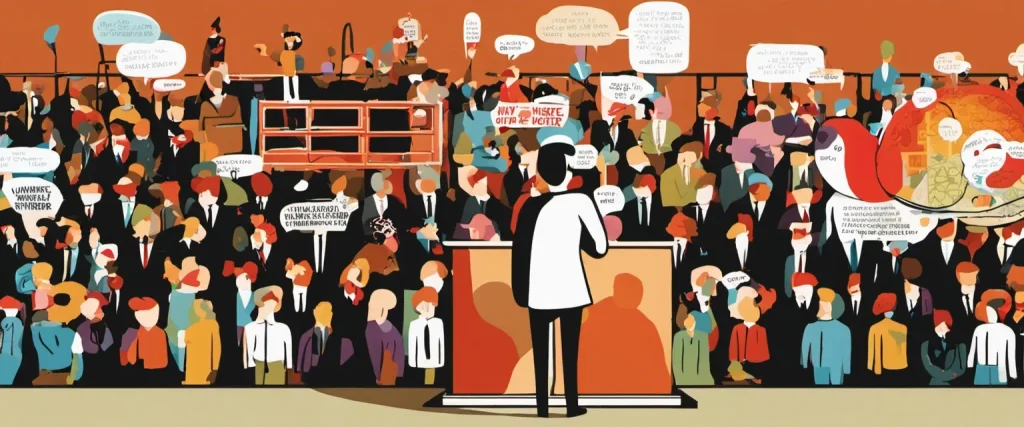In his insightful book, “Start with Why,” Simon Sinek explores the pivotal role of purpose in driving individual success and organizational performance. By delving into the “why” behind human behavior, Sinek uncovers the transformative power of understanding our intrinsic motivations. As a globally recognized leadership expert, Sinek is well-acquainted with the intricacies of inspiring others to action. With his engaging storytelling style and well-researched insights, he invites readers to reflect on their own purpose-driven aspirations, urging them to embrace a new perspective on success and make an impact that truly matters.
Chapter 1: Introduction to the Golden Circle
Chapter 1 of “Start with Why” by Simon Sinek introduces readers to the concept of the Golden Circle, which is the core framework discussed in the book. Sinek’s main intention is to help readers understand why some organizations or individuals are more successful and influential than others.
He starts by explaining that every organization or individual knows what they do and how they do it, but few truly understand why they do what they do. Sinek believes that the most successful leaders and organizations start with why they exist before moving on to the what and how.
The Golden Circle is represented by three concentric circles: the outer circle represents what an organization does, the middle circle represents how they do it, and the innermost circle represents why they do it. Sinek argues that most organizations operate from the outside in, promoting their product features (what) and unique selling points (how) before mentioning their purpose (why).
However, he emphasizes that influential leaders, such as Martin Luther King Jr. and Steve Jobs, inspire others by starting with the why. They first communicate their beliefs and values, creating an emotional connection with their audience. This approach taps into human biology, as people make decisions based on their emotions and then rationalize them with logic.
Sinek also explains the concept of the “Law of Diffusion of Innovation” and how it is affected by starting with the why. By focusing on the early adopters who believe what an organization believes, they can create a movement that ultimately influences the majority.
In summary, Chapter 1 introduces the Golden Circle concept, highlighting the importance of starting with why an organization or individual exists in order to inspire others and achieve long-term success and influence.
Chapter 2: The Biology of Why
Chapter 2: The Biology of Why in “Start with Why” by Simon Sinek explores the biological and neurological foundation behind the concept of starting with why. Sinek provides a deeper understanding of how our brains function and why certain actions or messages resonate with us.
The chapter begins by discussing the three key parts of the brain: the neocortex, the limbic brain, and the reptilian brain. The neocortex is responsible for rational and analytical thinking, while the limbic brain controls human behavior and decision-making based on emotions and feelings. The oldest part of the brain, the reptilian brain, handles our basic survival instincts and is driven by impulses and instincts.
Sinek explains that traditional marketing and communication strategies often focus on appealing to the neocortex, providing logical reasons to buy a product or service. However, he argues that the real power lies in appealing to the limbic brain by communicating the “why” behind what we do. By tapping into emotions and beliefs, we can create stronger connections and inspire action.
Furthermore, Sinek introduces the concept of the Golden Circle, which consists of three concentric circles: why, how, and what. Most organizations and leaders focus on the outer circle, the what, which represents the products or services they offer. However, he encourages a reversal of this approach, urging individuals and companies to start with the innermost circle, the why. Defining the purpose, cause, or belief behind their actions will enable them to effectively communicate their message and engage others on a deeper level.
In summary, Chapter 2 emphasizes that the limbic brain drives our behavior and decision-making, making it crucial to communicate the why behind our actions to inspire others. By understanding the biology behind how our brains function, Sinek reinforces the importance of starting with why when it comes to effective leadership, marketing, and communication.
Chapter 3: The Golden Circle in Action
Chapter 3: The Golden Circle in Action of the book Start with Why by Simon Sinek explores how successful individuals and organizations apply the principle of the Golden Circle to inspire others and drive remarkable achievements. The Golden Circle consists of three concentric circles: Why, How, and What, representing the three layers of how we think and act.
The chapter starts by delving into the case study of Steve Jobs, the co-founder of Apple, and his extraordinary ability to communicate with conviction and inspire millions with his Why. Jobs did not simply sell computers and gadgets; he was driven by a passion to challenge the status quo and provide a means for creative expression. By clearly conveying his purpose, he attracted a group of fiercely loyal customers who shared his beliefs.
Next, Sinek shares the story of the Wright brothers, who applied the Golden Circle to achieve the seemingly impossible task of inventing the first manned aircraft. Unlike their contemporaries, the Wright brothers were guided by a clear purpose, or Why: they believed in overcoming the limitations of gravity and enabling humans to fly. This allowed them to persist despite countless failures, leading to the eventual success of the airplane.
The chapter also emphasizes the importance of leadership and how it affects an organization’s ability to inspire. By embodying the Why and effectively communicating it to their teams, leaders like Martin Luther King Jr. and the pioneers behind the Civil Rights Movement were able to unite people and achieve lasting change.
To summarize, Chapter 3 of Start with Why illustrates the practical application of the Golden Circle in individuals and organizations. By starting with Why, rather than focusing solely on What or How, leaders and visionaries can inspire others, foster loyal followings, and accomplish remarkable things.
Chapter 4: The Celery Test

Chapter 4 of “Start with Why” by Simon Sinek is titled “The Celery Test.” In this chapter, Sinek explores the importance of understanding our biological drivers and how they affect our decision-making processes. The chapter begins with an analogy of a parent trying to feed their child healthy food, specifically celery, instead of French fries. Sinek uses this analogy to explain how our natural inclination towards instant gratification influences our choices and behaviors.
He explains that our brains are wired to seek out immediate rewards and avoid discomfort, which often leads us to make short-term decisions that may not align with our long-term goals or purpose. The concept of the “celery test” is introduced as a metaphor for self-discipline and delayed gratification.
Sinek further emphasizes the role of dopamine, a neurotransmitter that drives our desire for instant gratification. This chemical is released in response to immediate rewards, like eating French fries, providing us a pleasurable sensation. However, he argues that when we prioritize these short-term rewards, we overlook the long-term benefits of actions like eating celery that contribute to our overall health and well-being.
The author highlights the need to rewire our brains by consciously choosing actions that align with our purpose or goals. He suggests that clarity of purpose can help us endure discomfort and make decisions that may not provide immediate pleasure but are essential for long-term success.
Overall, Chapter 4 of “Start with Why” emphasizes the challenge of overcoming our biological drive for instant gratification and the need to focus on long-term visions, goals, and values in order to make decisions that truly fulfill us.
Chapter 5: The Origins of a Why
Chapter 5 of “Start with Why” by Simon Sinek explores the origins of a sense of purpose or “why” in individuals and organizations. Sinek argues that the key to discovering one’s why lies in our childhood experiences and the environments in which we were raised.
Sinek introduces the concept of the “Law of Diffusion of Innovation” which states that there are five types of people in the world – innovators, early adopters, early majority, late majority, and laggards. He explains that understanding our childhood experiences can help us identify which category we belong to and how that impacts our sense of purpose.
The author emphasizes that our sense of purpose often stems from moments of inspiration or mentorship during our formative years. These experiences lead us to believe in something beyond ourselves and instill in us a passion for a cause or belief. For some, a traumatic experience or adversity may be the catalyst that shapes their why.
Sinek highlights important childhood influences, such as parental figures or inspirational teachers, who share their values, beliefs, and stories. These influences play a crucial role in shaping our beliefs and determining our why. Moreover, the environment in which we grow up can greatly influence our sense of purpose. Sinek suggests that individuals who grow up in stable and supportive environments are more likely to have a strong sense of why.
The chapter concludes by emphasizing that discovering our why is a journey of self-reflection. We must examine our past, seek out mentors, and reflect on the moments that have shaped our values, beliefs, and passions. By understanding our childhood experiences and the environment in which we were raised, we can uncover our why and align our actions and decisions with our sense of purpose.
Chapter 6: Leadership Starts with Why
Chapter 6 of “Start with Why” by Simon Sinek is titled “Leadership Starts with Why.” In this chapter, Sinek emphasizes the importance of leaders understanding and communicating their sense of purpose or their “why” to inspire and lead their teams effectively.
Sinek starts by highlighting the examples of great leaders like Martin Luther King Jr., Steve Jobs, and the Wright brothers, who were able to inspire and mobilize people because they communicated their why effectively. These leaders had a clear vision and purpose, which enabled them to attract and inspire followers who deeply believed in their cause.
The author emphasizes that leaders must be able to articulate their why in a way that resonates with their team members. By doing so, leaders can create and foster a sense of purpose and commitment within their teams. Sinek argues that people are not motivated by a title or authority but by a greater purpose beyond themselves.
Furthermore, Sinek discusses the idea that leaders must align their actions with their why. It is not enough to simply talk about a purpose; leaders must embody and live it every day. This authenticity and consistency are crucial for gaining the trust and loyalty of team members.
The chapter concludes with a reminder that leadership is not about being in charge but about taking care of those in your charge. Leaders who start with why create environments where individuals can thrive, feel valued, and contribute their best to the organization’s mission.
In summary, Chapter 6 emphasizes the importance of leaders understanding, articulating, and living their sense of purpose. By doing so, leaders can inspire their teams to believe in and work towards a shared vision, creating a strong and loyal following.
Chapter 7: The New Competition
Chapter 7 of “Start with Why” by Simon Sinek explores the concept of “The New Competition.” Sinek explains how the modern business landscape has changed, and traditional notions of competition no longer hold true. He argues that organizations should shift their focus from outperforming competitors to outthinking them, in order to find lasting success.
Sinek begins by highlighting how companies have become obsessed with beating their rivals, measuring success solely in terms of market share, profit, and customer acquisition. However, this approach often leads to short-term gains and compromises on values and sustainability. To counter this, Sinek introduces the idea of the “Infinite Game” in business, where success is measured by the ability to stay in the game for the long run, rather than just winning against other players.
Furthermore, Sinek explains that the real competition lies within an organization itself, as individuals strive to be better versions of themselves. He emphasizes the importance of fostering a culture where employees feel safe, supported, and inspired, as this leads to higher levels of innovation and collaboration.
Sinek also challenges the overuse of price wars and discounts as means of attracting customers. He argues that focusing solely on price diminishes the value and unique offerings of a company, ultimately eroding loyalty and turning customers into mere transactional entities.
In this new competitive landscape, Sinek suggests that organizations should focus on their unique purpose, or their “Why.” By clearly articulating their Why, companies can attract customers and employees who believe in their cause, creating a sense of loyalty and engagement that transcends traditional notions of competition.
In conclusion, Chapter 7 of “Start with Why” encourages organizations to redefine their approach to competition. By shifting their focus from beating competitors to outthinking them, nurturing a supportive culture, and staying true to their purpose, companies can find lasting success in the infinite game of business.

Chapter 8: Discovering Your Why
Chapter 8 of “Start with Why” by Simon Sinek, titled “Discovering Your Why,” focuses on understanding the importance of finding one’s personal “why” and how it can enhance both professional and personal lives.
Sinek begins by highlighting the impact of having a clear sense of purpose. He argues that those who know their “why” are more motivated, fulfilled, and successful in their pursuits. To discover our “why,” Sinek suggests reflecting on our life experiences and identifying patterns or themes that have brought us joy, fulfillment, or a sense of accomplishment.
The author introduces the concept of the “golden circle,” which consists of three concentric circles: “why,” “how,” and “what.” The “why” represents the purpose, the reason for existence; the “how” represents the process or values guiding our actions; and the “what” represents the tangible results or products of these actions. Sinek emphasizes that starting with our “why” allows us to tap into our deepest motivations and harness our true potential.
Sinek encourages readers to ask themselves important questions to uncover their “why” and develop their personal vision. These questions include exploring childhood memories, identifying people who inspire admiration or respect, and considering what legacy one wishes to leave behind. By answering these questions honestly, individuals can gain clarity and articulate their personal “whys.”
The chapter also emphasizes the significance of aligning individual “whys” with the “whys” of organizations. When personal and organizational purposes align, individuals feel connected to something bigger than themselves, leading to a sense of fulfillment and stronger loyalty. The author cites various examples of renowned leaders and companies that embody this philosophy and have achieved remarkable success as a result.
Overall, Chapter 8 underscores the importance of discovering one’s personal “why” and integrating it into all aspects of life. By doing so, Sinek suggests that individuals can live more purposeful and fulfilling lives.
After Reading
In conclusion, “Start with Why” by Simon Sinek emphasizes the importance of leading with a clear sense of purpose in order to achieve long-lasting success and inspire others. Sinek presents compelling examples and research to support his argument that beginning with why, rather than focusing solely on the what and how, is key to building authentic connections and driving innovation. By understanding and communicating the deeper reasons behind our actions, we can create a sense of trust and loyalty among our teams and customers, ultimately leading to greater fulfillment and impact in both our personal and professional lives. Sinek’s book serves as a powerful reminder to always ask ourselves, “Why are we doing what we do?” before embarking on any endeavor.
1. “Extreme Ownership: How U.S. Navy SEALs Lead and Win” by Jocko Willink and Leif Babin: This book delves into the world of military leadership, providing insights on how to take responsibility for one’s actions and develop effective leadership skills. Drawing from their experiences as former Navy SEALs, Willink and Babin offer valuable lessons applicable to any team or organization.
2. The Lean Startup: How Today’s Entrepreneurs Use Continuous Innovation to Create Radically Successful Businesses” by Eric Ries: For anyone interested in entrepreneurship or innovation, this book is a must-read. Ries introduces the concept of the lean startup methodology, which emphasizes validated learning, experimentation, and iterative product development. This book offers practical advice on how to build and scale successful businesses in an ever-changing market.
3. The Power of Habit: Why We Do What We Do in Life and Business” by Charles Duhigg: Duhigg explores the science behind habits, providing a fascinating look at how they shape our lives and influence our decision-making processes. This book offers valuable insights for individuals and teams striving to change their habits, increase productivity, and create positive organizational routines.
4. Originals: How Non-Conformists Move the World” by Adam Grant: Grant challenges traditional thinking and encourages readers to embrace their originality. Drawing from research and captivating anecdotes, he explores how to champion new ideas, navigate resistance, and ultimately drive innovation. With actionable advice and inspiring stories, this book is perfect for individuals seeking to create meaningful change in their personal and professional lives.
5. Thinking, Fast and Slow” by Daniel Kahneman: In this captivating book, Kahneman, a Nobel laureate, delves into the fascinating world of human decision-making and cognition. By exploring the interplay between our quick, intuitive thinking (fast system) and our slow, logical thinking (slow system), he offers powerful insights into how we make choices. This book provides valuable lessons on avoiding cognitive biases and making better decisions, both as individuals and as teams.



